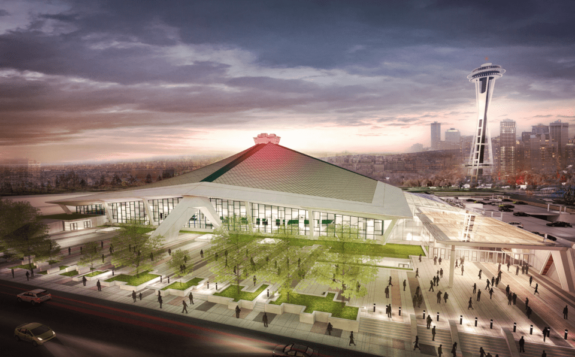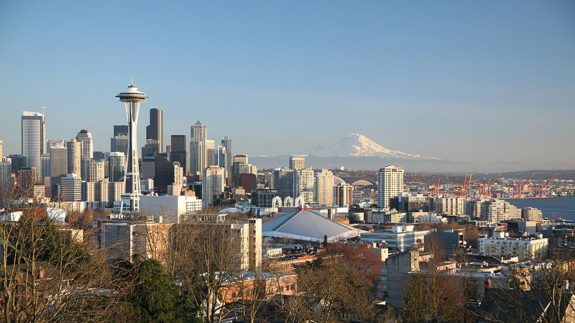The future home of the Seattle Kraken will be known as Climate Pledge Arena. The partners – Oakview Group, Amazon, and the NHL franchise itself – announced the arena name in June of this year, and, according to the partnership, it is more than just a name. As part of the renovation of the old Key Arena site, the group is making significant commitments to the environment.
They’re doing away with traditional power sources, aiming instead to utilize renewable energy in the operation of the arena. Buildings of this size and scope have significant electrical requirements, so that is quite a commitment to make.
Small Steps Toward a Better World
The Climate Pledge goes beyond renewable energy sources, though. The arena is planned to be the league’s first net zero-carbon facility. These are grand plans, and it is a good thing that the team and its sponsors are attempting to lead by example, but there will be challenges. One of the most significant ones may be the ice on the rink itself. There is an intention to have the “greenest ice in the NHL” through the use of collected rainwater for the ice sheets in the Kraken’s new home.

Being located in the often-damp Pacific Northwest, there should be no supply issues, but not all frozen water is created equally, and to meet NHL standards, they’ll need to treat the water prior to use. The group also plans to use ammonia, a natural refrigerant, in the freezing process rather than other potentially environmentally damaging ones. It could be that all of these techniques will be an improvement on the traditional ones used in other cities, but if there are sacrifices in their ice quality or the ice plant’s operational capabilities made to satisfy the zero-carbon commitment, there is a risk that it could affect the product on game nights.
Related: A Brief History of Rinkside Advertising
There’s an argument to be made that there’s a connection between your ice quality and your team’s success, and while having a great sheet to practice on is no substitute for good personnel and cap management, the players’ list of the league’s worst facilities does seem to coincide with some long streaks of mediocrity. For a team that may struggle to compete in its early seasons anyway, one hopes that dealing with subpar skating surfaces won’t be an additional hurdle.
Climate Pledge Arena Will Have a Great Menu
Moving past that one potential risk, there are other promises involved with this environmentally conscious arena. There will be minimal single-use plastics on opening night, going down to zero by 2024, and no garbage cans, instead only compost and recycling containers. The menu offerings, often a sore spot with fans, will be fresh, with 75 percent local products (defined as within a 300-mile radius of the city) and many vegan, vegetarian or pescatarian options suited to the culinary preferences of the local crowds. The beer and wine selection will also have significant Pacific Northwest influence.

The rink will not utilize natural gas, normally comprising up to 20 percent of the emissions of a building of this size. Cooking equipment, heating, cooling, and dehumidifying the ice surface will all be done using only electricity. Anyone who has cooked with gas knows that the instant heat and even temperature distribution aids in the cooking process. The electric power will be provided by solar panels – some on the building’s roof, some off-site – with only a backup generator using a small amount of diesel fuel. If we begin to see long lines at the concessions that don’t disappear when the next period begins, this may be something they need to reexamine.
All these choices mean that the carbon associated with putting on a hockey game or concert, either directly or incidentally, will be reduced. What carbon they do produce will be mitigated through the purchase of natural carbon offsets. The organization also intends to achieve internationally recognized environmental certification, through the International Living Future Institute which, if they are successful, will be a first for a sports and entertainment complex. They will track their carbon generation, measuring emissions in several categories, and reporting that information publicly.
Seattle Has a History of Climate Action
These efforts come about for a number of reasons. The common image of melting glacial ice in the world today has symbolic value for a hockey team. Amazon, who purchased the naming rights to the arena, has committed to significant carbon footprint reductions as a company, aiming to include numerous zero-carbon buildings within their real estate portfolio. The Climate Pledge, an effort to reach the emission levels set in the Paris Accords 10 years early, is clearly important to the retail giant and this partnership is clearly looking to lead the way on the issue.
Related: Deja Flu: Pandemic Wiped Out the 1919 Seattle-Montreal Stanley Cup Final
Seattle has always been an environmentally conscious city. It might be because of their historical connection with renewable resources, originally founded as a logging town, or it could be its people are perhaps more aware of the fragility of our planet, with both a destructive fire and an earthquake in their city’s past. Seattleites will be given every opportunity to arrive at the game in an eco-friendly manner. This is significant in the efforts to get to zero carbon, because 70 percent of the emissions created by an event have to do with the travel to and from the facility.

Metro buses, express buses, monorail, light rail, street car and even water taxis will be encouraged rather than driving yourself. On a smaller scale they plan to accommodate bicycles and scooters as well. Parking prices will be higher near the arena, encouraging thrifty environmentalists to pay less for parking in exchange for a little exercise. Pre-game and post-game events will also be planned, stretching out those arrival and departure windows where traffic crawls at a snail’s pace and idling engines are emitting carbon monoxide the whole time.
Construction Looks to Be on Schedule
The arena renovation, which broke ground in December of 2018, is coming along nicely, with the final structural beam put in place on Aug. 17. Based on recent construction projects of a similar nature, Rogers Place in Edmonton and T-Mobile Arena in Las Vegas, Seattle appears to be on schedule to host their first games in the fall of 2021.
The outside-the-box design ideas discussed above definitely break new ground, but they may be having a negative effect on the balance sheets – costs have risen from the originally proposed $564 million, up to somewhere between $800 and $900 million. The concept is cutting-edge, and if they are able to execute, it could signal a massive shift in the way these projects are put together. However, there is a fine line between the cutting edge and the bleeding edge, and one hopes these grand ambitions can become a reality.